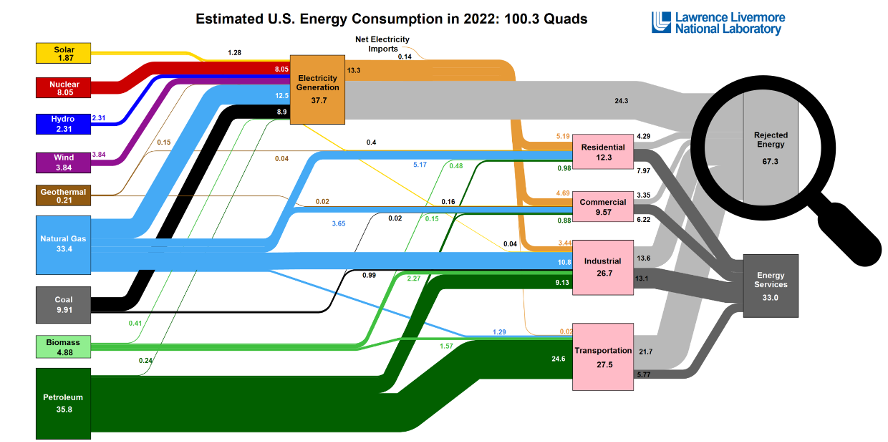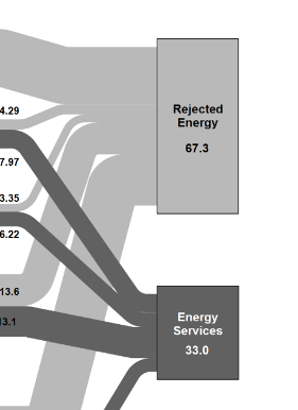The fossil industry is the problem not the solution: a barrier to efficiency and climate action


· 7 min read
The fossil fuel industry has long been aware of the risks associated with its products, yet it has actively concealed this information from the public and policymakers. This willful blindness has had devastating consequences for the environment, human health, and the global economy.
In 2022, despite record profits, the fossil fuel industry received a staggering $1.3 trillion in direct subsidies, according to the International Monetary Fund. This massive financial support from governments not only hinders climate action but also perpetuates the inherent inefficiency of our fossil fuel-based energy system. The Energy Waste Paradox revealed through Lawrence Livermore's (LLNL) energy flow charts, further exposes the shortcomings of this approach.
Lawrence Livermore's energy flow charts paint a stark picture: nearly half of the energy generated from fossil fuels is lost during conversion and distribution. This means that for every unit of electricity generated, only 0.6 units of useful energy reach consumers. This inefficiency is a significant drain on resources and contributes to the greenhouse gas emissions that threaten our planet.


Governments, despite signing the Paris Accord and committing to climate targets, continue to subsidize fossil fuels, with indirect subsidies accounting for 6% of the world's GDP. This means that governments are essentially pouring money into an industry that is harming the environment and our economy. In 2022, the fossil fuel industry's global profits reached $4 trillion, while emissions rose by almost a percent [321mm tons], according to the International Energy Agency (IEA). These figures highlight the hypocrisy of government policies that promote fossil fuels while simultaneously pursuing climate action goals.
The fossil fuel industry wields enormous lobbying power, which it uses to maintain its subsidies and block policies that would promote cleaner energy sources. This influence extends beyond governments to encompass the media and the public, creating a climate of misinformation that undermines efforts to transition away from fossil fuels.
The true cost of fossil fuel subsidies is much higher than the $1.3 trillion in direct subsidies that governments provide. According to Al Gore, the fossil fuel industry has been significantly underreporting its emissions for decades, and the true level of emissions is closer to 3 times the official figures. Pricing externalities, the most easily quantifiable externality is CO2 if this was priced at U$100/ton the true annual cost of fossil fuel subsidies would be closer to $10.8 trillion, a staggering amount of money that could be used to invest in renewable energy sources and other climate mitigation measures. (the EPA Social Cost of Carbon is U$190/ton LINK )
Numerous studies have shown that fossil fuel companies have known about the risks of climate change for decades. In fact, ExxonMobil conducted its own research as early as the 1970s, confirming that burning fossil fuels would lead to rising greenhouse gas emissions and global warming. However, the company chose to bury this research and downplay the risks in public statements.
The Lancet Commission on Pollution and Health found that pollution remains responsible for approximately 9 million deaths per year, corresponding to one in six deaths worldwide. These deaths are caused by a variety of pollutants, including those emitted by the fossil fuel industry.
In 2023, the United Nations Environment Programme (UNEP) issued a stark warning about the dangers of chemical pollution. The report found that the production of chemicals has doubled since 2000, leading to a 4-fold increase in the volume of hazardous chemicals in the environment. At the 2002 Earth Summit in South Africa, global leaders agreed to minimise the environmental and health effects of chemical pollution, perhaps the most insidious and problematic category. They set a deadline of 2020 by which time production would halve, by 2020 production had doubled. The US CDC found that 80% of urine samples from both children and adults contained a weedkiller linked to Cancer.
The Stockholm Environment Institute (SEI) has also documented the alarming growth of chemical pollution. The SEI's Global Chemicals Outlook 2023 found that the world is on a trajectory to produce 1 billion tonnes of plastic waste annually by 2030. This plastic waste will release a cocktail of toxic chemicals into the environment, harming human health and ecosystems.
Pollution, particularly endocrine-disrupting chemicals (EDCs), poor diets, air pollution, heavy metals, and toxic solvents can negatively impact fertility. These factors have led to a decline in sperm counts and egg quality, increasing the risk of infertility and reproductive complications, a recent study has shown sperm counts are at a 50-year low.
Despite optimistic estimates, recycling plastic will not significantly reduce CO2 emissions due to material losses at every step of the recycling process. These losses lead to a substantial need for fresh carbon input to meet growing demand, which could result in a 400–450 Mt annum increase in fresh input by 2050. This highlights the need to redesign single-use applications for recyclability and combine them with lowest-emission materials to achieve meaningful CO2 reductions.
Synthetic fertilizers, derived from fossil fuels, have played a significant role in agricultural productivity. However, their overuse has detrimental effects on soil health, microbial diversity, and food nutrition. Synthetic fertilizers can disrupt the delicate balance of soil microorganisms, reducing soil fertility and hindering the conversion of nitrogen from the air into a form that plants can utilize. This decline in soil microbes can lead to a decrease in the nutritional value of crops, as evidenced by a study showing that the average level of vitamin C in tomatoes grown with synthetic fertilizers was 30% lower than those grown organically.
Moreover, the widespread adoption of synthetic fertilizers and pesticides has contributed to a decline in the nutritional content of food over time. Studies have shown that the levels of vitamins, minerals, and antioxidants in fruits, vegetables, and grains have decreased significantly in recent decades. This decline can be attributed to several factors, including the overuse of synthetic chemicals, the selective breeding of crops for traits that prioritize yield and appearance over nutritional value, and the long-term storage of food.
The consequences of this nutritional decline are far-reaching, impacting the health of individuals and the sustainability of our food systems. A diet low in essential nutrients can increase the risk of chronic diseases such as heart disease, stroke, type 2 diabetes, and certain types of cancer. Additionally, the reliance on synthetic fertilizers and pesticides poses significant environmental risks, including water pollution, soil degradation, and greenhouse gas emissions.
The fossil fuel industry's repeated attempts to scaremonger about the costs of transitioning away from their products are disingenuous at best. They have benefited from decades of government subsidies and continue to receive billions of dollars in support, while externalizing the true costs of their operations, including emissions, pollution, and waste, onto the global population. The time for incremental change is long past; we must break free from this destructive pattern of externalizing environmental costs and embrace a systemic transformation that prioritizes sustainability.
This journey will undoubtedly be challenging, but the alternative – a future ravaged by climate change and environmental degradation – is far more daunting. We must rise to the challenge and forge a new path towards a more sustainable and equitable future, even if it means treating these fossil businesses like a bad bank in a financial crisis. Their assets need to be ring-fenced, and they should not be allowed to continue to profit from their destructive activities.
We must also stop criticizing the fossil businesses and expecting them to change without taking concrete action. Grandiose targets and resolutions at international summits have failed to reduce emissions, pollution, and waste in a meaningful way. The only way to start holding them accountable is by changing the playing field and creating a global price for carbon. They are not going to change their strategies unless we force them to do so. Their behavior in the months leading up to COP28 and during COP28 has only shown which side of the fence they have chosen.
Ultimately, this is a binary situation: you are either part of the problem (high anthropogenic emissions, pollutants, and waste) or part of the solution (low carbon, clean air, and a healthy biome). We cannot afford to have both.
illuminem Voices is a democratic space presenting the thoughts and opinions of leading Sustainability & Energy writers, their opinions do not necessarily represent those of illuminem.
Purva Jain

Energy Transition · Energy Management & Efficiency
illuminem briefings

Carbon Capture & Storage · Oil & Gas
Jordi Roca Jusmet

Climate Change · Oil & Gas
Politico

Public Governance · Oil & Gas
Oil Price

Oil & Gas · Upstream
Financial Times

Oil & Gas · Energy